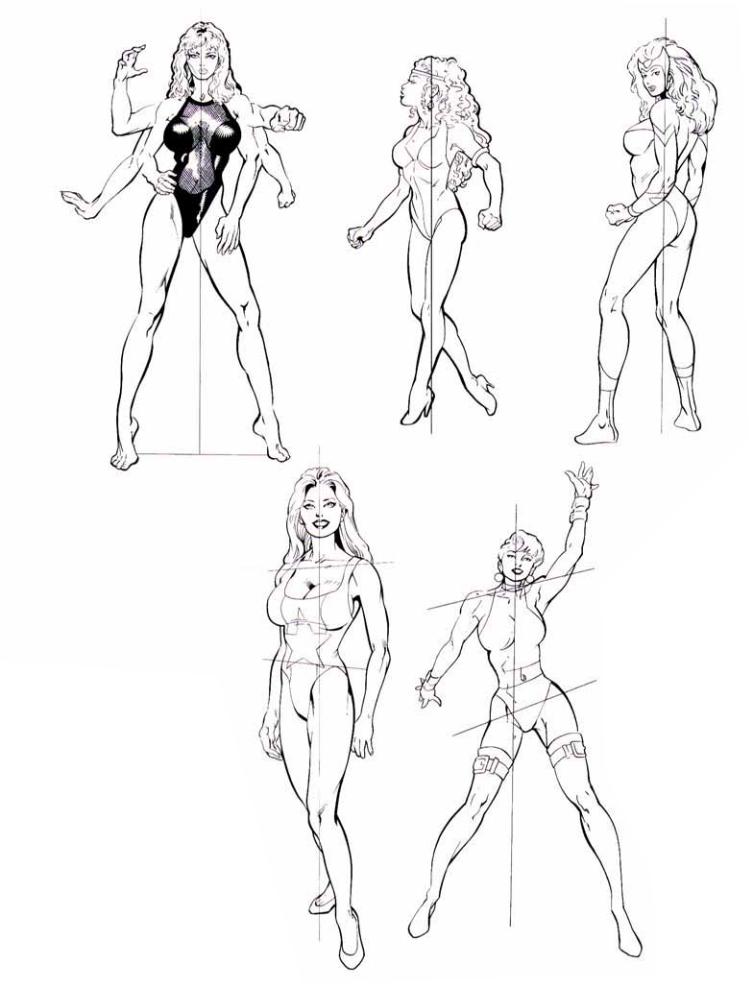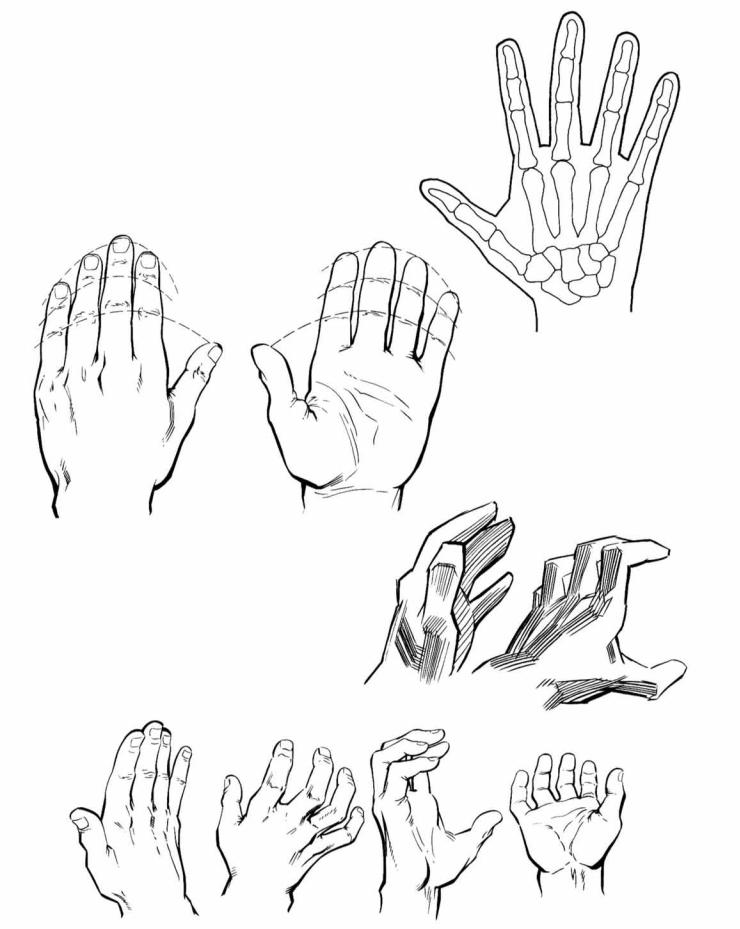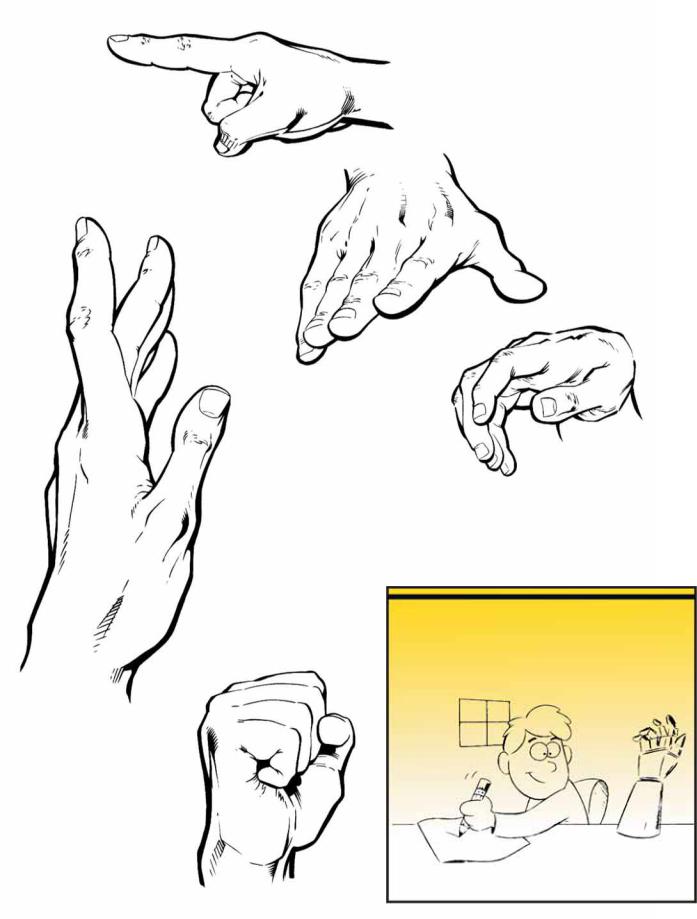
- •Acknowledgments
- •Contents
- •Introduction
- •The Contributing Artists
- •Sketching Different Head Shapes
- •Facial Features
- •How to Draw Hair
- •Popular Comic Book Expressions
- •Grimaces
- •Anatomical Proportions
- •Body Basics
- •Building an Action Pose
- •The Action Figure, Step By Step
- •The Heroic Female Figure
- •Anatomy of the Hand
- •Basic Hand Poses
- •Heroic Hands
- •Female Hands
- •Turnarounds
- •Devastating Punches
- •Clean Punches
- •The Lunge Attack
- •Leaning Into the Punch or Kick
- •The Judo Shoulder Throw
- •David vs. Goliath
- •The Balance of Power
- •The Renegade Soldier
- •Sword-and-Sorcery Villains
- •Forces of Evil
- •Inventing a Villain
- •Beastly Villains
- •Hollywood Heavies
- •Dressed to Kill
- •Unearthly Creatures
- •Comic Book Beauties Then...
- •Femme Fatales Yesterday...
- •...And Today
- •Denizen of the Street
- •Beauty in All Shapes and Colors
- •Drawing from Photos
- •Good Gal Heroes
- •Strong But Sexy
- •A Hint About Skintight Costumes
- •One-Point Perspective
- •Two-Point Perspective
- •The Horizon Line and the Figure
- •Multiple Figures in Perspective
- •Hanging Figures on a Horizontal Line
- •Creating Volume with Perspective
- •Dynamic Angles
- •From Start to Finish
- •Using Pattern and Value
- •Special Effects in Space
- •Bursts
- •Putting It All Together
- •Effective Composition
- •The Establishing Shot
- •What a Comic Book Script Looks Like
- •Thumbnail Sketches
- •The Rough Layout
- •Preparing a Pencil Layout for Inking
- •The Final Inked Page
- •Inking Like a Pro
- •Stuff You Need to Know
- •Art Supplies Shopping List
- •Reflections
- •Light Source
- •Shading
- •Varying An Ink Line
- •Folds and Drapery
- •Designing Costumes
- •Rapid Fire
- •In The Crosshairs
- •Hidden Danger
- •Aggressive Assault Vehicles
- •Off-Road
- •Mean Machines
- •Sky Patrol
- •Fighter Planes
- •How Things are Supposed To Get Done
- •How to Get Your First Job
- •Interview With A Noted Comic Book Editor and Publisher

THE HEROIC FEMALE FIGURE
T he heroic female figure has a fairly wide collarbone, resulting in square, well-muscled
shoulders. A woman's rib cage, bones, and all of her muscles are smaller than a man's. Her torso tapers sharply at the waist, but her pelvis is wider. As a rule, comic book women are drawn with more curves, while the men are drawn with more heavy angles.
For detailed information on how to draw comic book heroines, see "Beautiful But Deadly," pages 56-75.
BODY LINES
The center of balance is an imaginary vertical line drawn through the body. Half of the body's weight is on either side of the line, which maintains the body's balance. If the weight isn't distributed
evenly, the figure will fall down, bang her head, and sue. You don't want that.
Sometimes, though, it's okay, even necessary, to draw a character with his or her weight off balance. Can you think of an example? How about when a character is in motion? The act of walking is, in reality, a process of falling and catching yourself. If you were always in perfect balance you wouldn't be able to walk, because you couldn't transfer your weight from one foot to the other.
There are shoulder and hip lines to be aware of, too. This means that as one shoulder dips, the hip on that side of the body rises to compensate. Also, each time a limb or body mass extends past the center of balance, there must be an equal and opposite movement on the other side of the figure so that its balance is maintained.

CENTER OF BALANCE
SHOULDER LINE
HIP LINE
SHOULDER/HIP DYNAMICS
Notice that this figure's straight leg (her left one) is the weight-bearing leg. It pushes the hips up on that side. To compensate, the shoulder on the same side dips down. Conversely, on
the other side, her bent leg is supporting little of her body weight, therefore, the hip
on that side dips down. To compensate, the shoulder on the same side rises. We all make these adjustments in our posture constantly, but subconsciously.
ARM |
ARM |
|
FORWARD |
||
BACK |
||
|
ARM
ARM BACK
FORWARD
EXCEPTIONS
TO THE RULE
The human body is very versatile. Some extreme poses can shift the body so that both the shoulders and the hips are at the same angle. Don't be afraid to break the rules if it will make your poses more expressive.

ANATOMY OF THE HAND
Many beginning artists try to copy the dramatic hand poses of the pros without first taking a
look at the basic construction of the hand. Don't make the mistake of guessing on this important anatomical feature. I can evaluate the caliber of an artist by his or her ability to draw hands-and so can everyone else.
Each finger has three distinct joints that are marked with creases on both sides of the hand. Even on men's hands, the fingers taper at the ends.
DRAWING HANDS AT VARIOUS ANGLES
Start with a big shape, then break it down
into smaller shapes. Make sure to practice some turnarounds, an artist's term for rotating an object 360 degrees and drawing it from every angle (see pages 30-31).
Once you've gained some experience, you can draw "expressions" of the hand that are just as effective at conveying emotion as the face.
Look at the skeletal diagram of the hand above. Familiarize yourself with the arrangement of the bones and joints.
Note the various planes of the hand.

THE FINGER POINT
Best used by an angry boss threatening to fire a reporter. Note how both the heel of the thumb and part of the palm heel are visible in this pose.
THE FIST
Lifted in rage, or in combat. Note how the thumb overlaps the first two fingers, and how well defined the heel of the palm is.
STAGGERED
FINGERS
For a character who is explaining something. Note the large knuckle at the base of the thumb.
BASIC HAND POSES
Learn these basic hand poses and store them in your arsenal of techniques.
Notice how all the joints of the fingers are apparent, even when they aren't bent.
THE OPEN HAND
This is a standard hand pose, for when you don't need a specific hand gesture. Note how flat the tips of the fingers appear
THE RELAXED HAND
Use this one for heroes or villains who have been knocked unconscious by a blow or disabled by nerve gas. Note the severe turn at the wrist, which gives it its limp appearance.
To make a more in-depth study of the hand and its many poses, you can purchase a hand mannequin at an art supply store.
